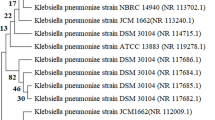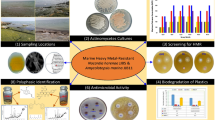Abstract
Bioremediation through biodegradation is applied for cleaning up several environmental pollutions including petroleum oil spill containing petrol, diesel, mobil, kerosene, lubricating, etc. which have devastated several endangered terrestrial and aquatic ecosystems. Therefore, the current research was aimed to isolate and identify diesel degrading bacteria from the petroleum waste dumping site and determined their degrading efficiency. The bacterial strains were isolated through a minimum salt medium supplemented with 2% diesel as the sole carbon source. The bacteria were identified by morphological, biochemical characterization, and 16S rRNA gene sequencing. The optimized growth pattern was evaluated by utilization of a wide range of temperatures (25, 30, 35, and 40 °C) and pH (5,6,7 and 8) as well as different concentrations of diesel (2, 3, 5and 7%). Finally, the degradation rate was determined by measuring the residual diesel after 7, 14, and 21 days of incubation. The study isolated Enterobacter ludwigii, Enterobacter mori, Acinetobacter baumannii, and Cedecea davisae where all are gram-negative rod-shaped bacilli. All the bacterial strains utilized the diesel at their best at 30 °C and pH 7, among them, A. baumannii and C. davisae exhibited the best degrading efficiency at all applied concentrations. Finally, the determination of degradation rate (%) through gravimetrical analysis has confirmed the potency of A. Baumannii and C. davisae where the degradation rate was around 61 and 52% respectively after 21 days of incubation period with 10% diesel. The study concludes that all of those isolated bacterial consortiums, especially A. baumannii and C. davisae could be allocated as active agents used for bioremediation to detoxify the diesel-containing contaminated sites in a cost-effective and eco-friendly way.




Similar content being viewed by others
Data availability
All the data expressed in the present paper will be readily available from me upon request (reza.gen@ru.ac.bd).
References
Adebusoye SA, Ilori MO, Amund OO, Teniola OD, Olatope S (2007) Microbial degradation of petroleum hydrocarbons in a polluted tropical stream. World J Microbiol Biotechnol 23:1149–1159
Balseiro-Romero M, Gkorezis P, Kidd PS, Van Hamme J, Weyens N, Monterroso C, Vangronsveld J (2017) Characterization and degradation potential of diesel-degrading bacterial strains for application in bioremediation. Int J Phytorem 19:955–963
Barnes NM, Khodse VB, Lotlikar NP, Meena RM, Damare SR (2018) Bioremediation potential of hydrocarbon-utilizing fungi from select marine niches of India. 3 Biotech 8:21
Cheesbrough M (2002) Medical laboratory manual for tropical countries, ELBS. Tropical health technology publications, UK, pp 2–392
Chen Q, Li J, Liu M, Sun H, Bao M (2017) Study on the biodegradation of crude oil by free and immobilized bacterial consortium in marine environment. PLoS ONE 12:e0174445
Chikere C, Ekwuabu C (2014) Molecular characterization of autochthonous hydrocarbon utilizing bacteria in oil-polluted sites at Bodo Community, Ogoni land, Niger Delta, Nigeria. Niger J Biotech 27:28–33
Collins C, Lyne P, Grange J, Falkinham III J (2004) Microbiological methods. Eight edition By Arnold:466
Das N, Chandran P (2011) Microbial degradation of petroleum hydrocarbon contaminants: an overview. Biotech Res Int 2011:1–3
de Souza CV, Corrêa SM (2016) Polycyclic aromatic hydrocarbons in diesel emission, diesel fuel and lubricant oil. Fuel 185:925–931
Doshi B, Sillanpää M, Kalliola S (2018) A review of bio-based materials for oil spill treatment. Water Res 135:262–277
Ekram MAE, Sarker I, Rahi MS, Rahman MA, Saha AK, Reza MA (2020) Efficacy of soil-borne Enterobacter sp. for carbofuran degradation: HPLC quantitation of degradation rate. J Basic Microbiol 60:390–399
Eze V, Onwuakor C, Orok F (2014) Microbiological and physicochemical characteristics of soil contaminated with used petroleum products in Umuahia, Abia State, Nigeria. J Appl Environ Microbiol 2:281–286
Gogoi B, Dutta N, Goswami P, Mohan TK (2003) A case study of bioremediation of petroleum-hydrocarbon contaminated soil at a crude oil spill site. Adv Environ Res 7:767–782
Greer CW, Juck DF (2017) Bioremediation of petroleum hydrocarbon spills in cold terrestrial environments, From Biodiversity to Biotechnology, Psychrophiles, pp 645–660
Hentati O, Lachhab R, Ayadi M, Ksibi M (2013) Toxicity assessment for petroleum-contaminated soil using terrestrial invertebrates and plant bioassays. Environ Monit Assess 185:2989–2998
Honda M, Suzuki N (2020) Toxicities of polycyclic aromatic hydrocarbons for aquatic animals. Int J Environ Res Public Health 17:1363
Ichor T, Okerentugba P, Okpokwasili G (2016) Biodegradation of total petroleum hydrocarbon by a consortium of Cyanobacteria isolated from crude oil polluted brackish waters of bodo creeks in Ogoniland, Rivers State Research. J Environ Toxicol 10:16
Irankhah S, Abdi Ali A, Mallavarapu M, Soudi MR, Subashchandrabose S, Gharavi S, Ayati B (2019) Ecological role of Acinetobacter calcoaceticus GSN3 in natural biofilm formation and its advantages in bioremediation. Biofouling 35:377–391
Karigar CS, Rao SS (2011) Role of microbial enzymes in the bioremediation of pollutants: a review. Enzyme Res 2011:805187
Lan H et al (2017) Complete genome sequence of Enterobacter sp. strain ODB01, a bacterium that degrades crude oil. Genome Announc 5:e01763-1716
MacFaddin J (2000) Biochemical tests for identification of medical bacteria. Williams and Wilkins, Philadelphia, p 113
Maddela NR, Masabanda M, Leiva-Mora M (2015) Novel diesel-oil-degrading bacteria and fungi from the Ecuadorian Amazon rainforest. Water Sci Technol 71:1554–1561
Mara K et al (2012) Molecular and phenotypic characterization of Acinetobacter strains able to degrade diesel fuel. Res Microbiol 163:161–172
Mortamais M et al (2017) Effect of exposure to polycyclic aromatic hydrocarbons on basal ganglia and attention-deficit hyperactivity disorder symptoms in primary school children. Environ Int 105:12–19
Mpongwana N, Ntwampe SK, Mekuto L, Akinpelu EA, Dyantyi S, Mpentshu Y (2016) Isolation of high-salinity-tolerant bacterial strains, Enterobacter sp., Serratia sp., Yersinia sp., for nitrification and aerobic denitrification under cyanogenic conditions. Water Sci Technol 73:2168–2175
Muthukamalam S, Sivagangavathi S, Dhrishya D, Rani SS (2017) Characterization of dioxygenases and biosurfactants produced by crude oil degrading soil bacteria. Braz J Microbiol 48:637–647
Nkem BM, Halimoon N, Yusoff FM, Johari WLW, Zakaria MP, Medipally SR, Kannan N (2016) Isolation, identification and diesel-oil biodegradation capacities of indigenous hydrocarbon-degrading strains of Cellulosimicrobium cellulans and Acinetobacter baumannii from tarball at Terengganu beach, Malaysia. Mar Pollut Bull 107:261–268
Olsson AC et al (2010) Occupational exposure to polycyclic aromatic hydrocarbons and lung cancer risk: a multicenter study in Europe. Occup Environ Med 67:98–103
Palanisamy N, Ramya J, Kumar S, Vasanthi N, Chandran P, Khan S (2014) Diesel biodegradation capacities of indigenous bacterial species isolated from diesel contaminated soil. J Environ Health Sci Eng 12:142
Rajendran P, Jayakumar T, Nishigaki I, Ekambaram G, Nishigaki Y, Vetriselvi J, Sakthisekaran D (2013) Immunomodulatory effect of mangiferin in experimental animals with benzo (a) pyrene-induced lung carcinogenesis. Int J Biomed Sci 9:68
Ramasamy S, Arumugam A, Chandran P (2017) Optimization of Enterobacter cloacae (KU923381) for diesel oil degradation using response surface methodology (RSM). J Microbiol 55:104–111
Sarkar P, Roy A, Pal S, Mohapatra B, Kazy SK, Maiti MK, Sar P (2017) Enrichment and characterization of hydrocarbon-degrading bacteria from petroleum refinery waste as potent bioaugmentation agent for in situ bioremediation. Biores Technol 242:15–27
Siddens LK et al (2012) Polycyclic aromatic hydrocarbons as skin carcinogens: comparison of benzo [a] pyrene, dibenzo [def, p] chrysene and three environmental mixtures in the FVB/N mouse. Toxicol Appl Pharmacol 264:377–386
Spini G et al (2018) Molecular and microbiological insights on the enrichment procedures for the isolation of petroleum degrading bacteria and fungi. Front Microbiol 9:2543
Sun S, Liu Q, Chen S, Yu W, Zhao C, Chen H (2019) Optimization for microbial degradation of petroleum hydrocarbon (TPH) by Enterobacter sp. S-1 using response surface methodology. Pet Sci Technol 37:821–828
Unwin J, Cocker J, Scobbie E, Chambers H (2006) An assessment of occupational exposure to polycyclic aromatic hydrocarbons in the UK. Ann Occup Hyg 50:395–403
Varjani SJ, Upasani VN (2016) Biodegradation of petroleum hydrocarbons by oleophilic strain of Pseudomonas aeruginosa NCIM 5514. Biores Technol 222:195–201
Xu X et al (2018) Petroleum hydrocarbon-degrading bacteria for the remediation of oil pollution under aerobic conditions: a perspective analysis. Front Microbiol 9:2885
Zeidler S, Müller V (2019) Coping with low water activities and osmotic stress in Acinetobacter baumannii: significance, current status and perspectives. Environ Microbiol 21:2212–2230
Zhang ZY, Pan LP, Li HH (2010) Isolation, identification and characterization of soil microbes which degrade phenolic allelochemicals. J Appl Microbiol 108:1839–1849
Zhang Q, Wang D, Li M, Xiang W-N, Achal V (2014) Isolation and characterization of diesel degrading bacteria, Sphingomonas sp. and Acinetobacter junii from petroleum contaminated soil. Front Earth Sci 8:58–63
Acknowledgements
All the authors would like to truthfully acknowledge the Institute of Biological Science (IBSc), and Central Laboratory, Department of Botany, University of Rajshahi, Bangladesh for providing the bacterial culture facilities. Again, The heartfelt gratitude from the author to Baneshwar Filling Station, Rajshahi for providing the soil sample.
Funding
This research did not receive any specific grant from funding agencies. This research work was carried out based on the internal fund of Molecular Biology and Protein Science Laboratory, Department of Genetic Engineering and Biotechnology, University of Rajshahi, Rajshahi-6205, Bangladesh.
Author information
Authors and Affiliations
Contributions
The conception of the study and experimental design carried out by IJ and MAR. Where IJ, TS, SAS were performed most of the experiments. MSR, IJ analyzed the results and prepared the manuscript. MSI has a contribution to statistical analysis. MAR and KMFH were involved in intellectual contribution and manuscript editing.
Corresponding author
Ethics declarations
Conflict of interest
The authors declare that there is no conflict of interest.
Additional information
Communicated by Erko Stackebrandt.
Publisher's Note
Springer Nature remains neutral with regard to jurisdictional claims in published maps and institutional affiliations.
Supplementary Information
Below is the link to the electronic supplementary material.
Rights and permissions
About this article
Cite this article
Jerin, I., Rahi, M.S., Sultan, T. et al. Diesel degradation efficiency of Enterobacter sp., Acinetobacter sp., and Cedecea sp. isolated from petroleum waste dumping site: a bioremediation view point. Arch Microbiol 203, 5075–5084 (2021). https://doi.org/10.1007/s00203-021-02469-2
Received:
Revised:
Accepted:
Published:
Issue Date:
DOI: https://doi.org/10.1007/s00203-021-02469-2




